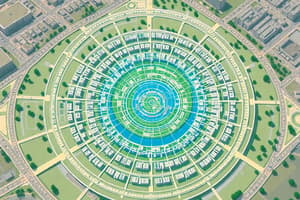Podcast
Questions and Answers
What is the definition of Urban Settlements?
What is the definition of Urban Settlements?
An urban settlement is an area that is more densely populated than surrounding areas.
What were the key factors required for the growth of early settlements?
What were the key factors required for the growth of early settlements?
- Population growth (correct)
- Social organization (correct)
- Advances in technology (correct)
- A favourable physical environment (correct)
Urbanization is the process by which an area changes from being urban to rural.
Urbanization is the process by which an area changes from being urban to rural.
False (B)
The Neolithic humans started establishing permanent settlements around 10,000 years ago.
The Neolithic humans started establishing permanent settlements around 10,000 years ago.
Match the following reasons for the formation of urban settlements:
Match the following reasons for the formation of urban settlements:
What is urban sprawl?
What is urban sprawl?
Which model explains that cities grow outward from a central area in a series of concentric rings?
Which model explains that cities grow outward from a central area in a series of concentric rings?
What does the Sector Model explain about city development?
What does the Sector Model explain about city development?
Match the following locations with their corresponding countries:
Match the following locations with their corresponding countries:
How does architecture relate to the urban context?
How does architecture relate to the urban context?
Flashcards are hidden until you start studying
Study Notes
Definition of Urban Settlements
- An urban settlement is a geographical area that constitutes a city or town, characterized by higher population density and vast human features compared to surrounding areas.
- Urban settlements can be cities, towns, or metropolitans, featuring an abundance of man-made structures in contrast to rural areas.
Origins of Urban Settlements
- Around 10,000 years ago, Neolithic humans began to establish permanent settlements, marking the beginning of urbanization.
- Four essential factors contributed to the growth of these settlements:
- Favourable physical environment (e.g., river valleys providing fresh water, fertile soils, and transportation)
- Advances in knowledge and technology (e.g., development of farming, surplus food, and trade)
- Social organization (e.g., class system, rules, and laws)
- Population growth (from 10 million to 500 million by 1650 AD)
Formation of Urban Settlements
- Urban settlements are formed through various reasons, including:
- Physical environment (e.g., river valleys, fertile ground)
- Religious (e.g., churches, temples, graves)
- Cultural (e.g., heritage sites, ancient civilizations)
- Political/Military (e.g., king's house, defensive walls)
- Economic (e.g., cities or ports of trade and economic activities)
Examples of Urban Settlements
- Maliseet village, South America
- Mesopotamia (Modern-day Iraq)
- Cliff Palace, Colorado (constructed by the Pueblo people between 900 and 1200 AD)
- Ancient Egypt and the River Nile
- Vatican, Rome
- Mount Temple, Jerusalem
- Athens, Greece
- Ile Ife, Nigeria
- Forbidden City, Beijing
- Antioch, Turkey
Growth of Urban Settlements
- Urbanization is the process by which an area changes from being rural to being urban, characterized by increased population density and expansion of urban functions.
- Urbanization occurs due to changes in the economy, advances in technology and lifestyle, creation of jobs, and migration.
- Reasons for urban growth include:
- Manufacturing
- Transportation
- Resource Use
- Service Centre
- Cumulative Causation
- Decentralization
- Gentrification
- Industrial growth
- Mall development
- Urban renewal
- Urban sprawl
Conurbation
- A conurbation is a region comprising multiple cities, large towns, and other urban areas that have merged to form a continuous urban and industrially developed area.
- Examples of conurbations:
- Johannesburg, Ekurhuleni, and Tshwane (South Africa)
- Lagos (Nigeria)
- Manila (Philippines)
- Mumbai Metropolitan Region (India)
- Germany's Rhine-Main, Rhine-Neckar, and Rhine-Ruhr regions
- Greater London (UK)
- New York (USA)
Urban Hierarchy
- A ranking of settlements according to their size and functions, with smaller towns offering basic services and larger cities offering more specialized services.
- Examples of urban hierarchy:
- Small town: grocery store, post office, elementary school
- Larger town: shopping, hospital, high school
- Very large city: television production, large universities, specialized hospitals, and entertainment
Urban Sprawl
- Urban sprawl refers to the uncontrolled, uncoordinated, and unplanned growth of urban areas, resulting in low-density communities reliant on automobile usage.
- Types of urban sprawl:
- Low-density sprawl: characterized by outward spreading of low-density suburban land use.
- Ribbon sprawl: characterized by concentration of development along major transportation arteries.
- Leapfrog development sprawl: a scattered form of urbanization with disjointed patches of urban land uses, interspersed with green areas.
Urban Structure Models
- Used to help explain where different types of people tend to live in urban areas and the use of land.
- Three types of urban structure models:
- Concentric Zone Model: city grows outward from a central area in a series of concentric rings.
- Sector Model: city develops in sectors, not rings.
- Multiple Nuclei Model: cities are complex structures with multiple centers around which activities revolve.
Architecture and Urban Context
- Architecture is the physical language of the city and reflects the society, culture, and religion of the area.
- Architecture is part of implementing an urban design project, which involves gathering insights into the urban fabric and how people use urban spaces.
Studying That Suits You
Use AI to generate personalized quizzes and flashcards to suit your learning preferences.




